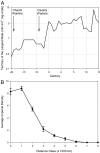War, space, and the evolution of Old World complex societies
- PMID: 24062433
- PMCID: PMC3799307
- DOI: 10.1073/pnas.1308825110
War, space, and the evolution of Old World complex societies
Abstract
How did human societies evolve from small groups, integrated by face-to-face cooperation, to huge anonymous societies of today, typically organized as states? Why is there so much variation in the ability of different human populations to construct viable states? Existing theories are usually formulated as verbal models and, as a result, do not yield sharply defined, quantitative predictions that could be unambiguously tested with data. Here we develop a cultural evolutionary model that predicts where and when the largest-scale complex societies arose in human history. The central premise of the model, which we test, is that costly institutions that enabled large human groups to function without splitting up evolved as a result of intense competition between societies-primarily warfare. Warfare intensity, in turn, depended on the spread of historically attested military technologies (e.g., chariots and cavalry) and on geographic factors (e.g., rugged landscape). The model was simulated within a realistic landscape of the Afroeurasian landmass and its predictions were tested against a large dataset documenting the spatiotemporal distribution of historical large-scale societies in Afroeurasia between 1,500 BCE and 1,500 CE. The model-predicted pattern of spread of large-scale societies was very similar to the observed one. Overall, the model explained 65% of variance in the data. An alternative model, omitting the effect of diffusing military technologies, explained only 16% of variance. Our results support theories that emphasize the role of institutions in state-building and suggest a possible explanation why a long history of statehood is positively correlated with political stability, institutional quality, and income per capita.
Keywords: cultural evolution; social complexity; ultrasociality.
Conflict of interest statement
The authors declare no conflict of interest.
Figures



Comment in
-
Does diffusion of horse-related military technologies explain spatiotemporal patterns of social complexity 1500 BCE-AD 1500?Proc Natl Acad Sci U S A. 2014 Jan 28;111(4):E414. doi: 10.1073/pnas.1322270111. Epub 2014 Jan 17. Proc Natl Acad Sci U S A. 2014. PMID: 24443554 Free PMC article. No abstract available.
-
Reply to Thomas: Diffusion of military technologies is a plausible explanation for the evolution of social complexity, 1500 BCE–AD 1500.Proc Natl Acad Sci U S A. 2014 Jan 28;111(4):E415. doi: 10.1073/pnas.1322988111. Proc Natl Acad Sci U S A. 2014. PMID: 24620368 Free PMC article. No abstract available.
References
-
- Campbell DT. The two distinct routes beyond kin selection to ultrasociality: Implications for the humanities and social sciences. In: Bridgeman D, editor. The Nature of Prosocial Development: Theories and Strategies. New York: Academic; 1983. pp. 11–39.
-
- Richerson PJ, Boyd R. The evolution of human ultrasociality. In: Eibl-Eibesfeldt I, Salter FK, editors. Ethnic Conflict and Indoctrination. Oxford: Berghahn; 1998. pp. 71–95.
-
- Bowles S. Microeconomics: Behavior, Institutions, and Evolution. Princeton, NJ: Princeton Univ Press; 2004.
-
- Fukuyama F. The Origins of Political Order: From Prehuman Times to the French Revolution. New York: Farrar, Straus, and Giroux; 2011.
-
- Richerson P, Henrich J. Tribal social instincts and the cultural evolution of institutions to solve collective action problems. Cliodynamics. 2012;3:38–80.
Publication types
MeSH terms
LinkOut - more resources
Full Text Sources
Other Literature Sources

